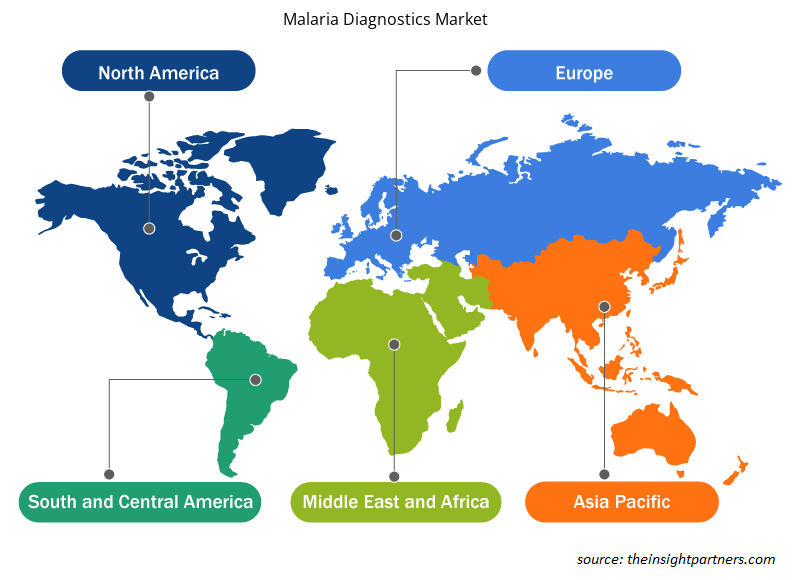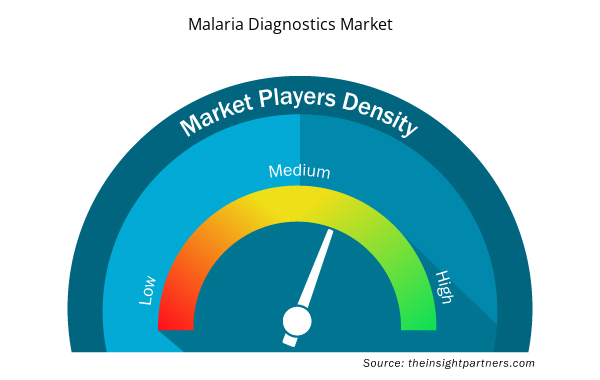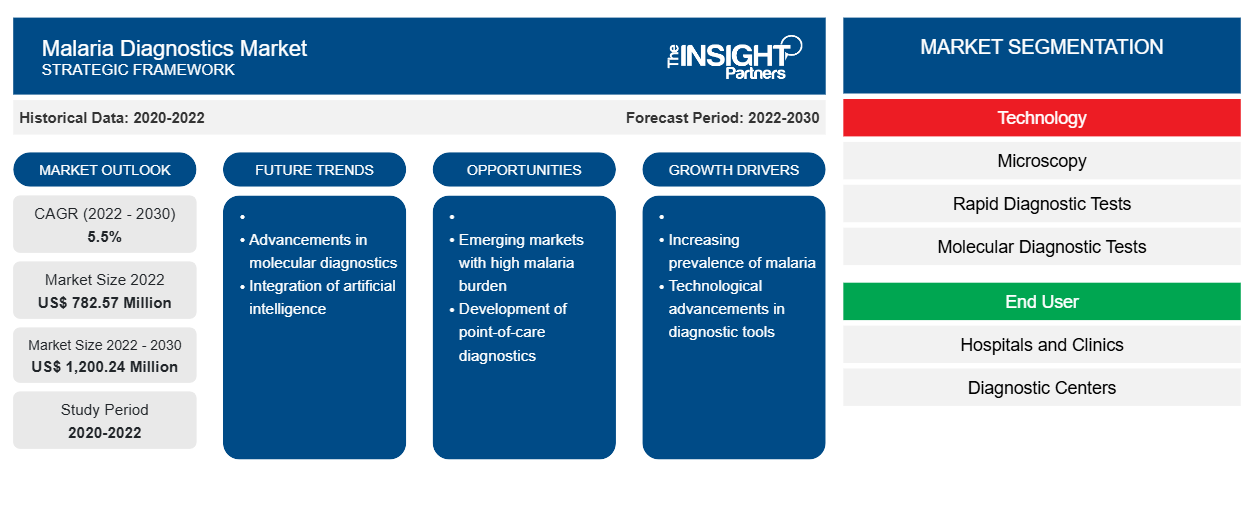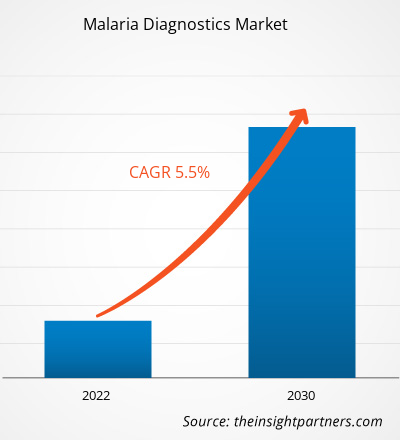[Rapporto di ricerca] Si prevede che il mercato della diagnostica della malaria crescerà da 782,57 milioni di dollari nel 2022 a 1.200,24 milioni di dollari entro il 2030; si stima che il mercato registrerà un CAGR del 5,5% nel periodo 2022-2030.
Approfondimenti di mercato e opinioni degli analisti:
La malaria è una malattia mortale causata dal parassita Plasmodium. Il mercato della diagnostica della malaria è in crescita a causa dell'elevata incidenza della malaria nei paesi a basso reddito e dei programmi di eliminazione della malaria implementati a livello globale da organizzazioni internazionali e nazionali. I crescenti lanci di strumenti diagnostici avanzati e le crescenti attività di ricerca per terapie efficaci stanno ulteriormente contribuendo alla crescita del mercato.
Prima della pandemia di COVID-19, quasi un terzo delle nazioni endemiche stava progredendo verso gli obiettivi internazionali. Molte nazioni a bassa incidenza facevano parte dell'"Elimination 2025 Initiative" dell'OMS, rappresentata da un gruppo di 25 nazioni che si impegnano a eliminare potenzialmente la malaria entro il 2025. D'altro canto, i progressi si sono fermati in circa un terzo dei paesi, mentre negli altri paesi l'incidenza della malaria è aumentata. I paesi con maggiori carichi di malattia stanno mostrando una maggiore inclinazione all'uso di dati di test diagnostici per stratificare e focalizzare interventi geograficamente idonei, indipendentemente dalla continua importanza dei test e dello screening nei tentativi di eradicazione.
Casi e decessi per malaria sono aumentati nel primo anno dell'epidemia di COVID-19 a causa di piccole interruzioni nella gestione dei casi e negli sforzi preventivi. Tuttavia, un possibile scenario peggiore, ovvero il raddoppio dei decessi per malaria, è stato evitato grazie agli sforzi congiunti dell'OMS, dei National Malaria Programs e dei partner. Difficoltà nell'ottenere le necessarie forniture per la malaria e l'incerto schema di come la pandemia ha influenzato in ultima analisi le misure di gestione della malaria.
Fattori di crescita:
La malaria, una delle malattie febbrili acute, è causata da parassiti plasmodium e si diffonde attraverso le zanzare femmine infette Anopheles. Cinque specie di parassiti negli esseri umani causano principalmente la malaria e due di queste specie, Plasmodium falciparum e P. vivax, sono considerate la minaccia più grande. Inoltre, P. falciparum è il parassita della malaria più mortale ed è più ampiamente diffuso nel continente africano. Inoltre, P. vivax è il parassita della malaria dominante nella maggior parte dei paesi al di fuori dell'Africa subsahariana. Secondo il World Malaria Report (WMR) 2020 dell'Organizzazione mondiale della sanità (OMS), sono stati segnalati 241 milioni di casi di malaria in tutto il mondo, rispetto ai 227 milioni di casi registrati nel 2019. Secondo la stessa fonte, il numero di decessi causati dalla malaria aumenta di 69.000 all'anno. Circa due terzi di questi decessi, ovvero 47.000, sono stati causati dalle interruzioni dei servizi sanitari durante la pandemia di COVID-19; il restante terzo dei decessi, ovvero 22.000, riflette un recente cambiamento nella metodologia dell'OMS per il calcolo della mortalità per malaria (indipendentemente dalle interruzioni dovute al COVID-19).
Nel 2020, circa il 95% dei casi globali e circa il 96% dei decessi causati dalla malaria sono stati segnalati nella regione africana dell'OMS e circa l'80% dei decessi totali segnalati riguardava bambini di età pari o inferiore a 5 anni. Secondo WMR 2021, circa il 2% del carico globale di malaria è stato registrato nei paesi del sud-est asiatico, dove l'India ha rappresentato l'83% dei casi di malaria stimati e l'82% dei decessi associati alla malattia nel 2020. Pertanto, la crescente prevalenza della malaria in diverse regioni a livello globale stimola la crescita del mercato della diagnostica della malaria.
Un numero limitato di prodotti prequalificati dall'OMS che sono mRDT non-Pf sono disponibili sul mercato. Nonostante la disponibilità di un'ampia gamma di prodotti mRDT prequalificati dall'OMS, la domanda è concentrata attorno a un sottoinsieme preferito di prodotti e produttori specifici. Ciò limita la capacità del mercato di garantire diversità di fornitura, sicurezza e capacità produttiva. In linea con ciò, i produttori affrontano sfide come la bassa domanda di prodotti da parte di alcuni paesi, nonché la loro riluttanza e mancanza di interesse nell'adottare prodotti alternativi. L'adozione di marchi alternativi può essere innescata dal cambiamento dei marchi selezionati per gli algoritmi nazionali o dalle implicazioni sui costi.
Personalizza questo report in base alle tue esigenze
Riceverai la personalizzazione gratuita di qualsiasi report, comprese parti di questo report, o analisi a livello nazionale, pacchetto dati Excel, oltre a usufruire di grandi offerte e sconti per start-up e università
- Scopri le principali tendenze di mercato in questo rapporto.Questo campione GRATUITO includerà analisi di dati che spaziano dalle tendenze di mercato alle stime e alle previsioni.
Segmentazione e ambito del report:
Il "mercato della diagnostica della malaria" è segmentato in base alla tecnologia e all'utente finale. Il mercato della diagnostica della malaria, in base alla tecnologia, è segmentato in microscopia, test diagnostici rapidi (RDT) e test diagnostici molecolari . Il segmento dei test diagnostici rapidi (RDT) ha detenuto la quota di mercato più grande nel 2022 e si stima che registrerà il CAGR più alto nel mercato nel periodo 2022-2030. Il mercato della diagnostica della malaria, in base all'utente finale, è suddiviso in ospedali e cliniche, centri diagnostici e altri. Il segmento degli ospedali e delle cliniche ha detenuto la quota di mercato più grande nel 2022. Si prevede che il segmento dei centri diagnostici registrerà il CAGR più alto nel mercato nel periodo 2022-2030.
Analisi segmentale:
In base alla tecnologia, il mercato della diagnostica della malaria è suddiviso in microscopia, test diagnostici rapidi (RDT) e test diagnostici molecolari.
Il segmento dei test diagnostici rapidi (RDT) ha detenuto la quota maggiore del mercato nel 2022 e si prevede che registrerà il CAGR più elevato nel mercato nel periodo 2022-2030. Dimostrando la presenza di parassiti della malaria nel sangue umano, i test diagnostici rapidi della malaria (RDT) aiutano nella diagnosi della malaria. I test diagnostici rapidi della malaria offrono un'alternativa alla diagnosi clinica o alla microscopia, soprattutto in situazioni in cui l'accesso a servizi di microscopia di alta qualità è limitato. Plasmodium falciparum o P. vivax è l'unica specie che alcuni RDT possono identificare, ma altri possono identificare quattro specie: P. falciparum, P. vivax, P. malariae e P. ovale. Di solito, si usa una puntura al dito per prelevare il sangue per il test.
Il mercato della diagnostica della malaria, per utente finale, è segmentato in ospedali e cliniche, centri diagnostici e altri. Ospedali e cliniche si stanno evolvendo notevolmente con il crescente numero di pazienti in tutto il mondo. Forniscono trattamenti altamente efficaci in contesti a basso costo. La crescente enfasi sull'uso di RDT per i loro rapidi tempi di risposta, i bassi costi e la comoda accessibilità è una delle cause principali del predominio delle cliniche nel mercato della diagnostica della malaria.
Analisi regionale:
Il mercato globale della diagnostica della malaria è segmentato geograficamente in Nord America, Europa, Asia Pacifico, Sud e Centro America e Medio Oriente e Africa. Grazie ai crescenti investimenti da parte di nazioni sviluppate come gli Stati Uniti e gli USA, alle popolazioni di pazienti più numerose e alla crescente enfasi da parte dell'Organizzazione mondiale della sanità (OMS) sulla riduzione del tasso di mortalità per malaria nei paesi africani, si prevede che la regione del Medio Oriente e dell'Africa manterrà il suo predominio di mercato nel periodo di previsione. Sulla base dei dati pubblicati dall'OMS a luglio 2022, è probabile che l'Africa subsahariana rappresenti circa il 95% dei casi di malattia e il 96% dei decessi.
Approfondimenti regionali sul mercato della diagnostica della malaria
Le tendenze regionali e i fattori che influenzano il mercato della diagnostica della malaria durante il periodo di previsione sono stati ampiamente spiegati dagli analisti di Insight Partners. Questa sezione discute anche i segmenti e la geografia del mercato della diagnostica della malaria in Nord America, Europa, Asia Pacifico, Medio Oriente e Africa e America meridionale e centrale.

- Ottieni i dati specifici regionali per il mercato della diagnostica della malaria
Ambito del rapporto di mercato sulla diagnostica della malaria
| Attributo del report | Dettagli |
|---|---|
| Dimensioni del mercato nel 2022 | 782,57 milioni di dollari USA |
| Dimensioni del mercato entro il 2030 | 1.200,24 milioni di dollari USA |
| CAGR globale (2022-2030) | 5,5% |
| Dati storici | 2020-2022 |
| Periodo di previsione | 2022-2030 |
| Segmenti coperti | Per tecnologia
|
| Regioni e Paesi coperti | America del Nord
|
| Leader di mercato e profili aziendali chiave |
|
Densità degli operatori del mercato della diagnostica della malaria: comprendere il suo impatto sulle dinamiche aziendali
Il mercato della diagnostica della malaria sta crescendo rapidamente, spinto dalla crescente domanda degli utenti finali dovuta a fattori quali l'evoluzione delle preferenze dei consumatori, i progressi tecnologici e una maggiore consapevolezza dei benefici del prodotto. Con l'aumento della domanda, le aziende stanno ampliando le loro offerte, innovando per soddisfare le esigenze dei consumatori e capitalizzando sulle tendenze emergenti, il che alimenta ulteriormente la crescita del mercato.
La densità degli operatori di mercato si riferisce alla distribuzione di aziende o società che operano in un particolare mercato o settore. Indica quanti concorrenti (operatori di mercato) sono presenti in un dato spazio di mercato in relazione alle sue dimensioni o al valore di mercato totale.
Le principali aziende che operano nel mercato della diagnostica della malaria sono:
- Accesso Bio., Inc.
- Laboratori Abbott
- Società a responsabilità limitata Premier Medical Corporation Pvt. Ltd.
- Azienda: Sysmex Partec GmbH
- bioMérieux
Disclaimer : le aziende elencate sopra non sono classificate secondo un ordine particolare.

- Ottieni una panoramica dei principali attori del mercato della diagnostica della malaria
Sviluppi del settore e opportunità future:
Di seguito sono elencati vari sviluppi strategici da parte dei principali attori che operano nel mercato della diagnostica della malaria:
- Nel febbraio 2022, il Kenya Medical Research Institute (KEMRI) ha lanciato Plasmochek per i test sulla malaria. Plasmochek è progettato per rilevare il plasmodium, un parassita responsabile della malaria. Il kit utilizza anticorpi specifici per la proteina II ricca di istidina del Plasmodium falciparum e lattato deidrogenasi del Plasmodium per rilevare le infezioni da malaria.
- Nel dicembre 2019, Access Bio e Global Good (un partner di collaborazione del primo) hanno sviluppato un nuovo test diagnostico rapido ultrasensibile (uRDT) che è cinque volte più sensibile nell'identificazione degli antigeni della proteina 2 ricca di istidina (HRP2) rispetto agli uRDT attualmente disponibili. Inoltre, sono stati creati vari strumenti per migliorare la diagnosi della malaria.
Scenario competitivo e aziende chiave:
Access Bio., Inc.; Abbott Laboratories; Premier Medical Corporation Pvt. Ltd.; Sysmex Partec GmbH; bioMerieux; Beckman Coulter Inc.; Siemens Healthineers; Leica Microsystems GmbH; Nikon Corporation; Olympus Corporation; e Bio-Rad Laboratories Inc. sono le aziende di spicco nel mercato della diagnostica della malaria. Queste aziende si concentrano su nuove tecnologie, sull'aggiornamento dei prodotti esistenti e sulle espansioni geografiche per soddisfare la crescente domanda dei consumatori in tutto il mondo.
- Analisi storica (2 anni), anno base, previsione (7 anni) con CAGR
- Analisi PEST e SWOT
- Valore/volume delle dimensioni del mercato - Globale, regionale, nazionale
- Industria e panorama competitivo
- Set di dati Excel


- Lyophilization Services for Biopharmaceuticals Market
- Industrial Valves Market
- Oxy-fuel Combustion Technology Market
- Medical Collagen Market
- Digital Pathology Market
- Investor ESG Software Market
- Occupational Health Market
- Antibiotics Market
- Environmental Consulting Service Market
- Visualization and 3D Rendering Software Market

Report Coverage
Revenue forecast, Company Analysis, Industry landscape, Growth factors, and Trends

Segment Covered
This text is related
to segments covered.

Regional Scope
North America, Europe, Asia Pacific, Middle East & Africa, South & Central America

Country Scope
This text is related
to country scope.
Domande frequenti
Asia Pacific is expected to be the fastest growing region in the malaria diagnostics market. The growth of the market in Asia Pacific is anticipated to grow at a faster pace owing to factors such as growing need for superior treatment solutions, increasing focus on research and development activities. Additionally, India reported an 83.34% reduction in malaria morbidity and a 92% decrease in associated mortality during 2000–2019. The Centers for Disease Control and Prevention (CDC) claims that pregnant women are three times more susceptible to malaria infections as compared to others. Thus, rapid diagnosis and subsequent treatment plans are essential, which favor the growth of the malaria diadnostics market in India.
The malaria diagnostics market, based on end user, classified into hospitals and clinics, diagnostic centers, and others. The hospitals and clinics segment held the largest market share in 2022. The diagnostic centers segment is expected to register the highest CAGR in the market during 2022–2030.
The malaria diagnostics market, based on technology, is segmented into microscopy, rapid diagnostic tests (RDTs), and molecular diagnostic tests. The rapid diagnostic tests (RDTs) segment held the largest market share in 2022 and is estimated to register the highest CAGR in the market during 2022–2030.
Middle East and Africa holds the largest market share in malaria diagnostics market. Growing incidences of malaria is leading to increasing demand for malaria diagnostics. The market growth is owing to factors such as growing demand for rising awareness regarding malaria treatment and rising disposable income.
The factors that are driving growth of the market are increasing research and development activities and advancements in informatic solutions and imaging systems.
Malaria is a life-threatening disease caused by the plasmodium parasite. The malaria diagnostics market is growing due to the high incidence of malaria in low-income countries and globally implemented malaria elimination programs by international and national organizations. The increasing launches of advanced diagnostic tools and rising research activities for effective therapeutics are further contributing to the growth of the market.
The malaria diagnostics market majorly consists of the players such as Access Bio., Inc.; Abbott Laboratories; Premier Medical Corporation Pvt. Ltd.; Sysmex Partec GmbH; bioMerieux; Beckman Coulter Inc.; Siemens Healthineers; Leica Microsystems GmbH; Nikon Corporation; Olympus Corporation; and Bio-Rad Laboratories Inc. among others.
Trends and growth analysis reports related to Life Sciences : READ MORE..
The List of Companies - Malaria Diagnostics Market
- Access Bio., Inc.
- Abbott Laboratories
- Premier Medical Corporation Pvt. Ltd.
- Sysmex Partec GmbH
- bioMérieux
- Beckman Coulter, Inc.
- Siemens Healthineers
- Leica Microsystems GmbH
- Nikon Corporation
- Olympus Corporation
- Bio-Rad Laboratories, Inc.
The Insight Partners performs research in 4 major stages: Data Collection & Secondary Research, Primary Research, Data Analysis and Data Triangulation & Final Review.
- Data Collection and Secondary Research:
As a market research and consulting firm operating from a decade, we have published and advised several client across the globe. First step for any study will start with an assessment of currently available data and insights from existing reports. Further, historical and current market information is collected from Investor Presentations, Annual Reports, SEC Filings, etc., and other information related to company’s performance and market positioning are gathered from Paid Databases (Factiva, Hoovers, and Reuters) and various other publications available in public domain.
Several associations trade associates, technical forums, institutes, societies and organization are accessed to gain technical as well as market related insights through their publications such as research papers, blogs and press releases related to the studies are referred to get cues about the market. Further, white papers, journals, magazines, and other news articles published in last 3 years are scrutinized and analyzed to understand the current market trends.
- Primary Research:
The primarily interview analysis comprise of data obtained from industry participants interview and answers to survey questions gathered by in-house primary team.
For primary research, interviews are conducted with industry experts/CEOs/Marketing Managers/VPs/Subject Matter Experts from both demand and supply side to get a 360-degree view of the market. The primary team conducts several interviews based on the complexity of the markets to understand the various market trends and dynamics which makes research more credible and precise.
A typical research interview fulfils the following functions:
- Provides first-hand information on the market size, market trends, growth trends, competitive landscape, and outlook
- Validates and strengthens in-house secondary research findings
- Develops the analysis team’s expertise and market understanding
Primary research involves email interactions and telephone interviews for each market, category, segment, and sub-segment across geographies. The participants who typically take part in such a process include, but are not limited to:
- Industry participants: VPs, business development managers, market intelligence managers and national sales managers
- Outside experts: Valuation experts, research analysts and key opinion leaders specializing in the electronics and semiconductor industry.
Below is the breakup of our primary respondents by company, designation, and region:

Once we receive the confirmation from primary research sources or primary respondents, we finalize the base year market estimation and forecast the data as per the macroeconomic and microeconomic factors assessed during data collection.
- Data Analysis:
Once data is validated through both secondary as well as primary respondents, we finalize the market estimations by hypothesis formulation and factor analysis at regional and country level.
- Macro-Economic Factor Analysis:
We analyse macroeconomic indicators such the gross domestic product (GDP), increase in the demand for goods and services across industries, technological advancement, regional economic growth, governmental policies, the influence of COVID-19, PEST analysis, and other aspects. This analysis aids in setting benchmarks for various nations/regions and approximating market splits. Additionally, the general trend of the aforementioned components aid in determining the market's development possibilities.
- Country Level Data:
Various factors that are especially aligned to the country are taken into account to determine the market size for a certain area and country, including the presence of vendors, such as headquarters and offices, the country's GDP, demand patterns, and industry growth. To comprehend the market dynamics for the nation, a number of growth variables, inhibitors, application areas, and current market trends are researched. The aforementioned elements aid in determining the country's overall market's growth potential.
- Company Profile:
The “Table of Contents” is formulated by listing and analyzing more than 25 - 30 companies operating in the market ecosystem across geographies. However, we profile only 10 companies as a standard practice in our syndicate reports. These 10 companies comprise leading, emerging, and regional players. Nonetheless, our analysis is not restricted to the 10 listed companies, we also analyze other companies present in the market to develop a holistic view and understand the prevailing trends. The “Company Profiles” section in the report covers key facts, business description, products & services, financial information, SWOT analysis, and key developments. The financial information presented is extracted from the annual reports and official documents of the publicly listed companies. Upon collecting the information for the sections of respective companies, we verify them via various primary sources and then compile the data in respective company profiles. The company level information helps us in deriving the base number as well as in forecasting the market size.
- Developing Base Number:
Aggregation of sales statistics (2020-2022) and macro-economic factor, and other secondary and primary research insights are utilized to arrive at base number and related market shares for 2022. The data gaps are identified in this step and relevant market data is analyzed, collected from paid primary interviews or databases. On finalizing the base year market size, forecasts are developed on the basis of macro-economic, industry and market growth factors and company level analysis.
- Data Triangulation and Final Review:
The market findings and base year market size calculations are validated from supply as well as demand side. Demand side validations are based on macro-economic factor analysis and benchmarks for respective regions and countries. In case of supply side validations, revenues of major companies are estimated (in case not available) based on industry benchmark, approximate number of employees, product portfolio, and primary interviews revenues are gathered. Further revenue from target product/service segment is assessed to avoid overshooting of market statistics. In case of heavy deviations between supply and demand side values, all thes steps are repeated to achieve synchronization.
We follow an iterative model, wherein we share our research findings with Subject Matter Experts (SME’s) and Key Opinion Leaders (KOLs) until consensus view of the market is not formulated – this model negates any drastic deviation in the opinions of experts. Only validated and universally acceptable research findings are quoted in our reports.
We have important check points that we use to validate our research findings – which we call – data triangulation, where we validate the information, we generate from secondary sources with primary interviews and then we re-validate with our internal data bases and Subject matter experts. This comprehensive model enables us to deliver high quality, reliable data in shortest possible time.


 Ottieni un campione gratuito per questo repot
Ottieni un campione gratuito per questo repot